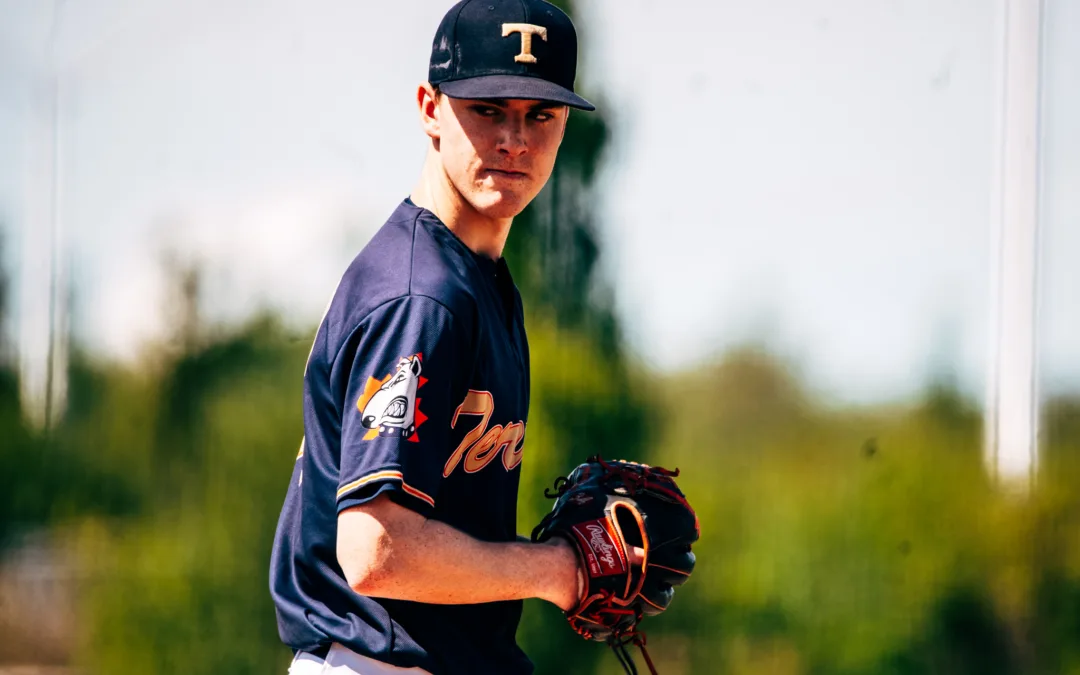Original Author: Rick Johnston, TBZ Co-Founder
Co-Authors: Ben Abram, Ian Bala, Jayson Eljawhary
Editors: Jayson Eljawhary, Luke Tevlin
An underappreciated and often under-coached aspect of pitching is the development of pitchers away from the mound. Most pitchers spend countless hours working on their delivery, adding or removing a pitch within their repertoire, and conditioning their body and mind in the personal development of becoming a successful pitcher. What many pitchers fail to excel at is learning how to field their position once the ball has been put in play – as a pitcher, you must understand that once the ball leaves your hand, you are no longer a pitcher and are as much of a fielder as the other eight players on the diamond. In baseball terms, this type of development is referred to as PFPs.
PFPs
Pitcher’s Fielding Practice, or PFPs, is a routine of structured practices designed around game situations that will occur throughout the season. Pitchers need to become adept, accountable, and responsible for a multitude of defensive situations on a daily basis. Ideally, as a coach (or pitcher), it is best to ensure that each pitcher has a clear understanding of their role once a ball has been put in play, yet many do not! The concept of PFPs is to create a plan, draft, or blueprint of what each responsibility is based on where the ball is hit and/or where to go with or without the ball.
Because PFPs are often taken for granted due to its tedious mundane or boring approach, mental errors are often the leading culprit of physical errors on the mound. Pitchers need to take the approach that every rep they take during their PFP work must be with the utmost focus, intent, and conviction to the task at hand.
A prime example of a failure to focus on fielding as a pitcher would be the Detroit Tigers in the 2006 World Series. In that series, eventually won by the St. Louis Cardinals, the Tigers pitchers committed a total of five errors – yes that is five errors – that had glaring and costly effects on outcomes of games. Here is what former Tigers pitcher Justin Verlander said: “I couldn’t really believe I did it. Being an athlete on the mound is something I’ve prided myself on, getting myself out of jams. I just messed up.”
2006 World Series
Jim Leyland, arguably one of the greatest managers in his era and recent Baseball Hall of Fame inductee, had this to say: “In the American League you don’t handle a lot of bunts and stuff. We knew we were going to do that in this series, so we worked on it during the time frame we were off and quite frankly we didn’t execute it during the World Series. I’m responsible and I accept that responsibility. It’s my job to have my team ready.” This of course was in reference to the difference in playing styles between the American League and National League, when there was no universal designated hitter and therefore the latter league saw more small-ball (bunting) strategies.
The key to what Verlander said was not getting out of the jam, but him saying that he prides himself on “being an athlete” on the mound. Pitchers need to strive to do this – be an athlete, not just a pitcher.
Getting out of jams is not just making the right pitch or picking a runner off or a defensive player making an unbelievable play to end an inning. It can boil down to a case of the pitcher being able to field his position and unfortunately, in the end, these errors put a dagger deep in the backs of the Tigers in 2006. Let’s look at a few different examples of common PFP game scenarios:
1. Between The Mound and 1st Base Line
Perhaps the most common PFPs scenarios involve some kind of play between the mound and first base line and require some form of communication between the pitcher & first baseman, pitcher & catcher, or pitcher, catcher, & first baseman. Examples of these scenarios usually include ground balls to first base, where the pitcher must cover the base with both nobody on as well as on double plays. Also included should be bunts where the pitcher, catcher, and first basemen all have to communicate on who takes the ball and who covers first.
2. Between The Mound and 3rd Base Line
This area of the field usually requires pitchers to communicate with the third baseman on comebackers, as well as communication with the third baseman and/or catcher on bunts or “swinging bunts” where the ball is hit very softly, usually a rollover. Pitchers must also be prepared to cover third base depending on the scenario (runners on base, where the shortstop is playing, aggressive bunt defenses, etc).
3. Situational Plays
When a pitcher fields the ball outright and has to make a decision on where to throw the ball with multiple options. An example of this could be with a runner on first base and less than two out on a comebacker to the mound, a pitcher must have the sense to get the lead runner at 2nd base where possible. Another example of this would be if the bases were loaded with less than two out – on a comebacker to the mound, a pitcher must know instinctively to go home with the ball to get the lead runner. In both scenarios, a double play is possible or even likely, but poor baseball sense and lack of awareness could lead to giving up a free run or out and come back to haunt you later in the inning.
These kinds of scenarios are where practicing PFPs can either have the greatest benefits or consequences to you and your team!
4. Backing Up Bases
Pitchers also have a responsibility to make sure that no base is left unattended. The most common instances seen in younger age groups is after a wild pitch or passed ball occurs, and a pitcher is still standing on the mound while the catcher is at the back stop retrieving the ball. If there are runners on 2nd and 3rd before the pitch, this will almost always lead to a run. If there are runners on 1st and 2nd before the pitch, this could lead to a run if a pitcher is not paying attention. Also, on any ball to the outfield, the pitcher should be backing up the throw to whatever base the ball is headed towards. This will change based on where the runners are, which will require situational awareness and awareness of the cutoff systems in place.
In conclusion, the moral of this blog is if pitchers do not work on PFPs, then there is a very good chance that somewhere down the road, when a Baseball 101 situation happens with a pitcher, they can affect their team in a negative or positive manner and could very well be the difference maker in their team winning or losing.


